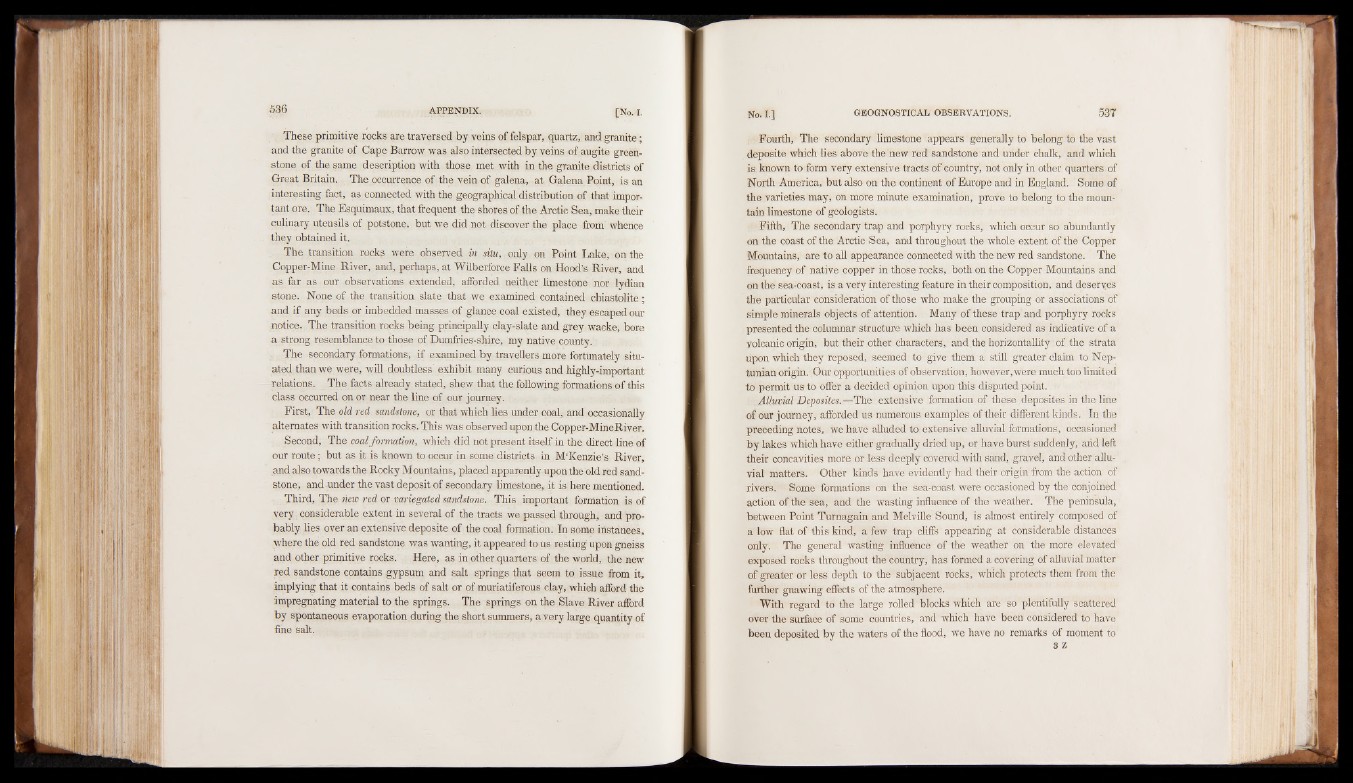
These primitive rocks are traversed by veins of felspar, quartz, and granite;
and the granite of Cape Barrow was also intersected by veins of augite greenstone
of the same description with those met with in the granite districts of
Great Britain. The occurrence of the vein of galena, at Galena Point, is an
interesting fact, as connected with the geographical distribution of that important
ore. The Esquimaux, that frequent the shores of the Arctic Sea, make their
culinary utensils of potstone, but we did not discover the place from whence
they obtained it.
The transition rocks were observed in situ, only on Point Lake, on the
Copper-Mine River, and, perhaps, at Wilberforce Falls on Hood’s River, and
as far as our observations extended, alforded neither limestone nor lydian
stone. None of the transition slate that we examined contained chiastolite ;
and if any beds or imbedded masses of glance coal existed, they escaped our
notice. The transition rocks being principally clay-slate and grey wacke, bore
a strong resemblance to those of Dumffies-shire, my native county.
The secondary formations, if examined by travellers more fortunately situated
than we were, will doubtless exhibit many curious and highly-important
relations. The facts already stated, shew that the following formations of this
class occurred on or near the line of our journey.
First, The old red sandstone, or that which lies under coal, and occasionally
alternates with transition rocks. This was observed upon the Copper-MineRiver.
Second, The coal formation, which did not present itself in the direct line of
our route; but as it is known to occur in some districts in M'Kenzie’s River,
and also towards the Rocky Mountains, placed apparently upon the old red sandstone,
and under the vast deposit of secondary limestone, it is here mentioned.
Third, The new red or variegated sandstone. This important formation is of
very considerable extent in several of the tracts we passed through, and probably
lies over an extensive deposite of the coal formation. In some instances,
where the old red sandstone was wanting, it appeared to us resting upon gneiss
and other primitive rocks. Here, as in other quarters of the world, the new
red sandstone contains gypsum and salt springs that seem to issue from it,
implying that it contains beds of salt or of muriatiferous clay, which afford the
impregnating material to the springs. The springs on the Slave River afford
by spontaneous evaporation during the short summers, a very large quantity of
fine salt.
Fourth, The secondary limestone appears generally to belong to the vast
deposite which lies above the new red sandstone and under chalk, and which
is known to form very extensive tracts of country, not only in other quarters of
North America, but also on the continent of Europe and in England. Some of
the varieties may, on more minute examination, prove to belong to the mountain
limestone of geologists.
Fifth, The secondary trap and porphyry rocks, which occur so abundantly
on the coast of the Arctic Sea, and throughout the whole extent of the Copper
Mountains, are to all appearance connected with the new red sandstone. The
frequency of native copper in those rocks,, both on the Copper Mountains and
on the sea-coast, is a very interesting feature in their composition, and deseryes
the particular consideration of those who make the grouping or associations of
simple minerals objects of attention. Many of these trap' and porphyry rocks
presented the columnar structure which has been considered as indicative of a
Volcanic origin, but their other characters, and the horizontallity of the strata
upon which they reposed, seemed to give'them a still greater claim to Neptunian
origin. Our opportunities of observation, however, were much too limited
to permit us to offer a decided opinion upon this disputed point.
. Alluvial Deposites.—The extensive formation of . those deposites in the line
of our journey, afforded us numerous examples, of their different kinds. In the
preceding notes, we have alluded to extensive alluvial formations, occasioned
by lakes which have either gradually dried up, or have burst suddenly, and left
their concavities more or less deeply covered with sand, gravel, and other alluvial
matters. Other kinds have evidently had their origin from the action of
rivers. Some formations on the sea-coast weTe occasioned by the conjoined
action of the sea, and the wasting influence of the weather. The peninsula,
between Point Turnagain and Melville Sound, is almost entirely composed of
a low flat of this kind, a few trap cliffs appearing at considerable distances
only. The general wasting influence of the weather on the more elevated
exposed rocks throughout the country, has formed a covering of alluvial matter
of greater or less depth to the subjacent rocks, which protects them from the
further gnawing effects of the atmosphere.
With regard to the large rolled' blocks which are so plentifully scattered
over the surface of some countries, and which have been considered to have
been deposited by the waters of the flood, we have no remarks of moment to
3 Z